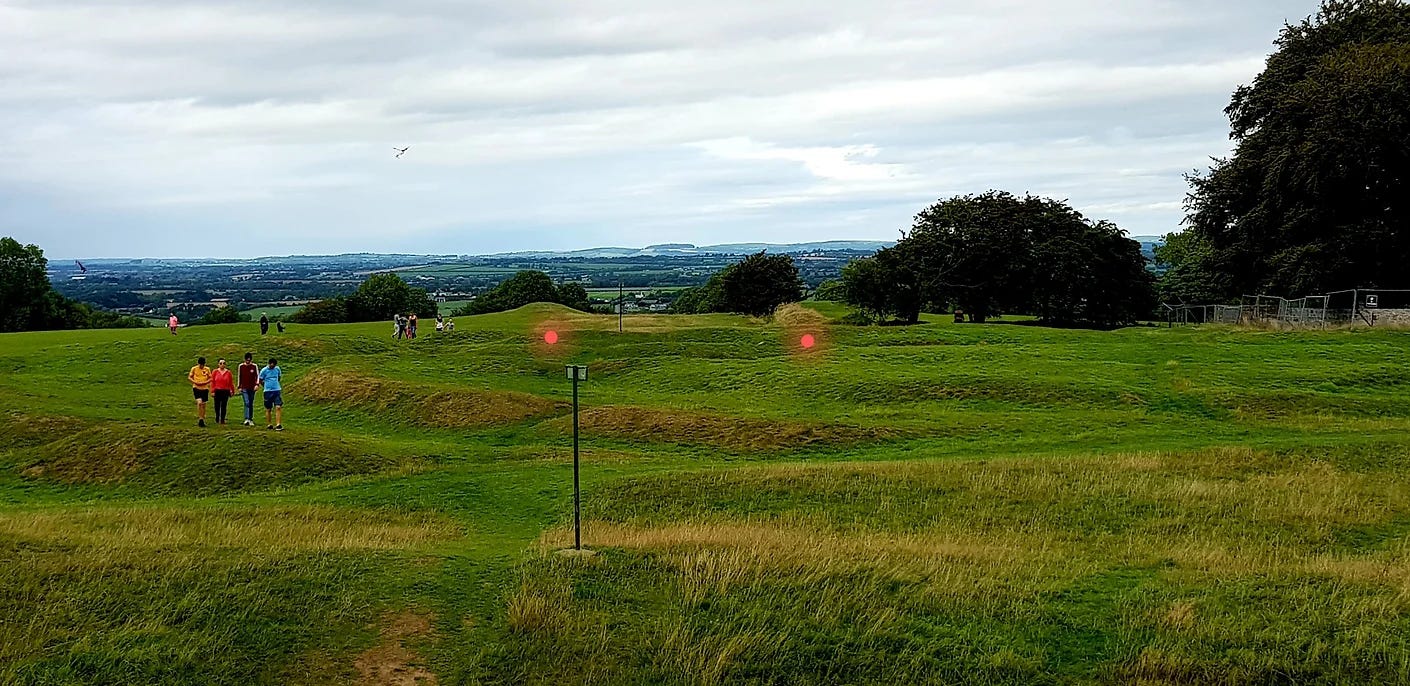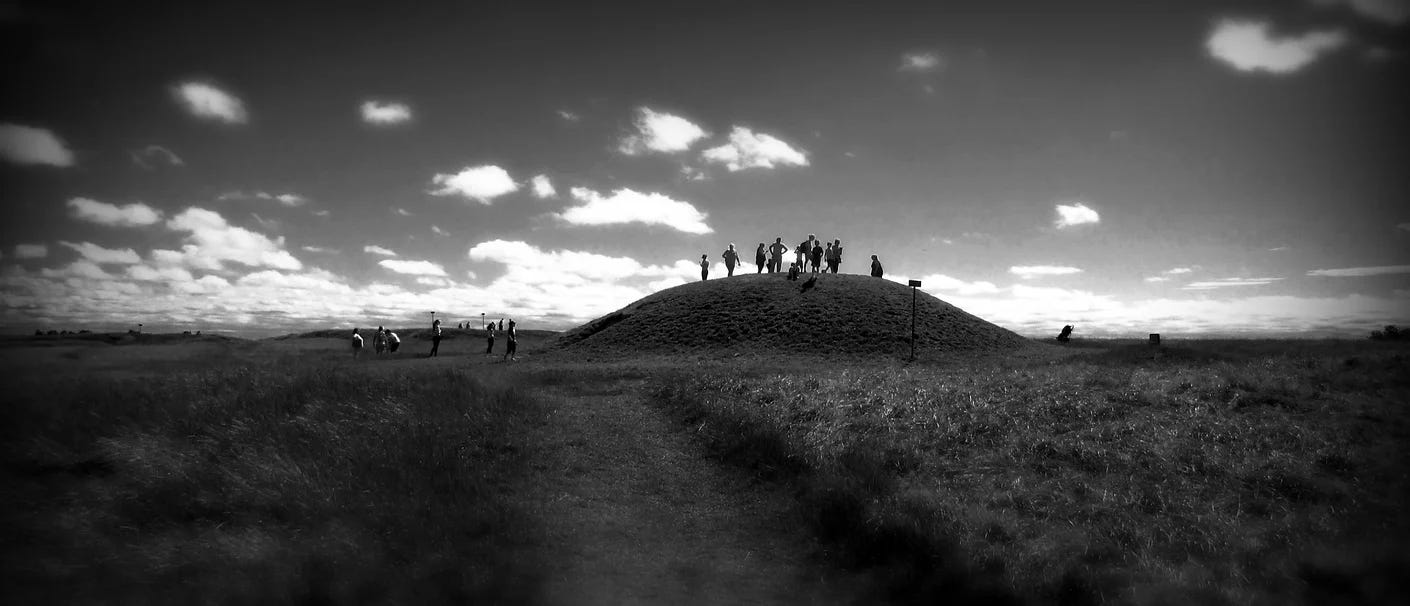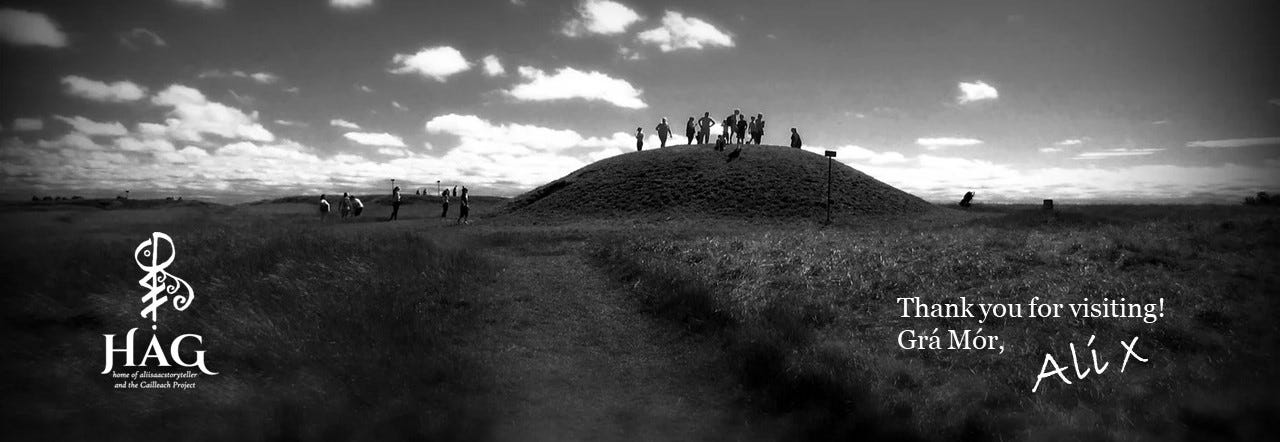Walking the Ceremonial Path at the Hill of Tara
A closer look at the so-called Tech Midchúarta, or 'Banqueting Hall'.
"thrice fifty stately couches there were, and fifty men to each shining couch. Seven cubits, an honest reckoning, before the crowded warlike company, 55] with blazing torches burning, that was the measure of the hearth. Other seven, I have heard, made in truth a brightness beyond denial, majestic, notable, noble, 60] beautiful chandeliers of brass. This sunny shining citadel, festive, martial, with cask-staves, therein, amid radiant hospitality, were doors twice seven in number" Excerpt from Poem 4, The Metrical Dindshenchas, author unknown, Celt.ucc.ie.
You may recall that early writers described this feature as the banqueting hall of the Kings of Tara, naming it Tech Midchúarta, which in Irish means “House of Mead Circling”. We now know it was in actual fact, an ancient road by which the summit of Tara and all its monuments are approached. Evidence such as the raised embankments with their irregular slots suggest a ritual, or ceremonial purpose.
This is how Conor Newman describes the feature:
Tech Midchúarta is a linear earthwork comprising two arcuate but nonetheless parallel banks, 25m to 28m apart and 203m long. Over this distance it rises more than 8m. It was made by scarping, or scraping away the soil in the middle and piling it into the two banks on either side. The result is that the whole surface of the interior has been lowered and is markedly below exterior ground level.
The banks rise to above head height, or at least the west bank still does; the east bank has been ploughed over and is considerably more denuded. The banks, therefore, are higher from the inside because the viewer is standing on a lowered surface. At irregular intervals along each bank are narrow gaps, possibly as many as 11 in total.
In its original state, one would have ascended Tech Midchúarta without being able to see out from either side. Moreover, up ahead would have been nothing other than the skyline; just like today, there would have been no indication of what awaited the traveller ascending the hill. It is, in short, a monument designed to deprive one of the otherwise celebrated views from the Hill of Tara. So doing, it removes the visitor temporarily from the familiar, outside world, into an enclosed, interior space.
So I decided to walk the length of the Tech Midchúarta from its beginning (as it exists today) to the top, and here is a short film of that experience in real time.
Unfortunately, the tech which supports directly embedding video clips in Substack posts is currently still in beta , but click the button to view a short film of my ascension to the top of the Hill of Tara via the Tech Midchúarta.
You can see that the pathway is very broad and seems very shallow. However, if you look to left and right, you can see that the embankments rise higher than your head. The slots which have been cut away in the embankments show that you are walking at a level below ground level; all you can see through them is the grass at the surface meeting the sky.
Above you is the sky. You can see nothing but the ground at your feet gradually rising as you traverse along it, the embankments at your sides, and the sky. The embankments force all sound up and over your head so all you can hear is the wind, no birds, or other visitors to the site. As you walk along the Tech Midchúarta, all is eerily blanketed and still. It really is an extraordinary experience.
And then suddenly you are at the top, and all is revealed. Before you lies the remains of the Rath of Synods and immediately beyond that, the object which automatically draws your eyes: the Mound of Hostages.
Newman suggests that the slots which are cut into the embankment are placed to reveal strategic glimpses of particular monuments at the site as one traverses the path. At first, I believed this to be the case, because as I walked along the top of one of the embankments, I could see Rath Grainne through the first slot.
But from inside the Tech Midchúarta, all you can see is grass and sky through the first slot – no Rath Grainne. You wouldn’t even know it was there. You can see this in the video.
So either this theory is wrong, or perhaps less permanent features once stood in these niches, like carvings of Gods and Goddesses perhaps, or maybe even people, possibly spectators. It is also possible that these slots enabled other pathways to join or intersect with the main processional route. Who knows? All we can do is speculate.

It should be remembered that the embankments have been somewhat denuded by time, erosion, and the action of agriculture and various other human activities over the centuries, and most likely stood considerably higher than they do today. The church would not have stood to the left of the pathway just as one reaches the top, either, so who knows what once stood there before it. However, none of this detracts from the experience, and if you go to Tara, I highly recommend approaching it this way, rather than through the churchyard.
You can read more about the ceremonial roads and pathways of Ireland in the following two posts:
and












Hi Sarah! I think that would be a great idea! Photos are fab, but film really gives people a sense of immersion and how a place FEELS! Without professional filming skills, I think the effect can be more true to life and raw. You're not trying to create atmosphere, add effects, or 'improve' what you're filming, you're just offering what you are experiencing. So go for it! And thank you so much for taking the time to get in touch! 💕
Oh I love this! Your little film really captures the energy of the place. There's a hillfort quite close to where I live which also has very tall ramparts. I've been meaning to make a video and now you've inspired me!